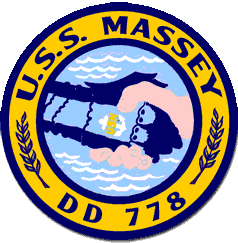In April 1958, CDR Charles J. Hemmingson relieved CDR. Daniel V. James as Commanding Officer.
In November 1959 CDR. Stephen L. Rusk relieved CDR. Charles J. Hemmingson.
By late 1944, as the speed and power of aircraft greatly increased, the 40-mm and 20-mm were less effective. After World War II, the Soviet submarine threat was a major concern. The destroyer took on the challenge of this underwater threat which during the 1950s, resulted in two major standoff weapons, the Drone Anti-Submarine Helicopter (DASH) and the Anti-Submarine Rocket (ASROC). The standard procedure for ASW in WW II was for the surface ship to pass as close as possible over the submarine to drop underwater explosives. Both the SUMNER and GEARING classes were aging and in need of major overhaul and reconstruction to accommodate the new weapons systems. After careful analysis of the situation, the Secretary of the Navy ordered the Fleet Rehabilitation and Modernization (FRAM) program. This amounted to a complete refurbishment of the ship’s hull and machinery and the addition of new superstructure. The FRAM program consisted of two levels of modernization with the FRAM II developed primarily for the SUMNERs, which had insufficient hull length amidships to accommodate the ASROC system.
After 15 years of carrying out the missions of a destroyer, MASSEY entered the Norfolk Naval Shipyard in December 1959 for a 7-month overhaul FRAM II program. In addition to the new helicopter flight deck and hanger for the DASH, numerous new equipment and structures were installed to give the ship greater capabilities and extended life. The DASH drone was a basic airframe for a 300 horsepower turbine, a 50 gallon fuel tank, and a lightweight avionics package. Two counter-rotating blades provided lift and forward/aft movement through data linked signals generated by operator manipulation of the remote console directional joy stick, altitude, and speed controls. The DASH carried 2 MK-46 torpedoes and cruised at 90-100 knots with a flight duration of about one hour. The new superstructure including the hanger to house two DASH helicopters was made of aluminum to prevent the ship from being top-heavy. The helicopter deck and hanger provided an area of great versatility.

Note: The historical information provided on this web site is not the official history of the USS MASSEY. It is based in part on the recollection of many authors, some former Commanding Officers, all former MASSEY shipmates, who contributed to developing the chronology of events that marked some of the noteworthy contributions of this fine Man O' War to our Navy's history over nearly 30 years of active service.

